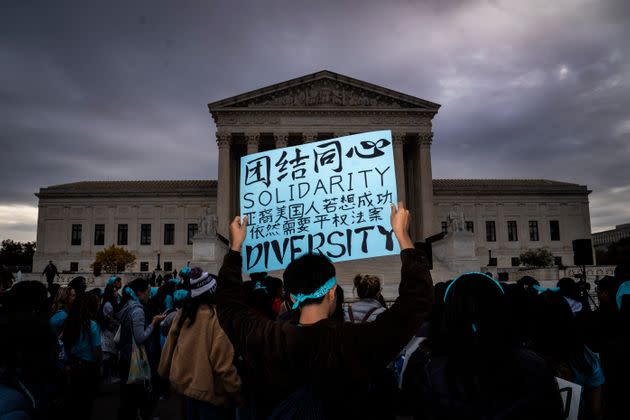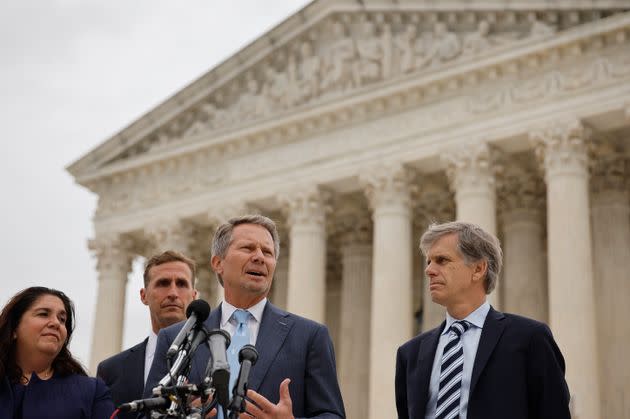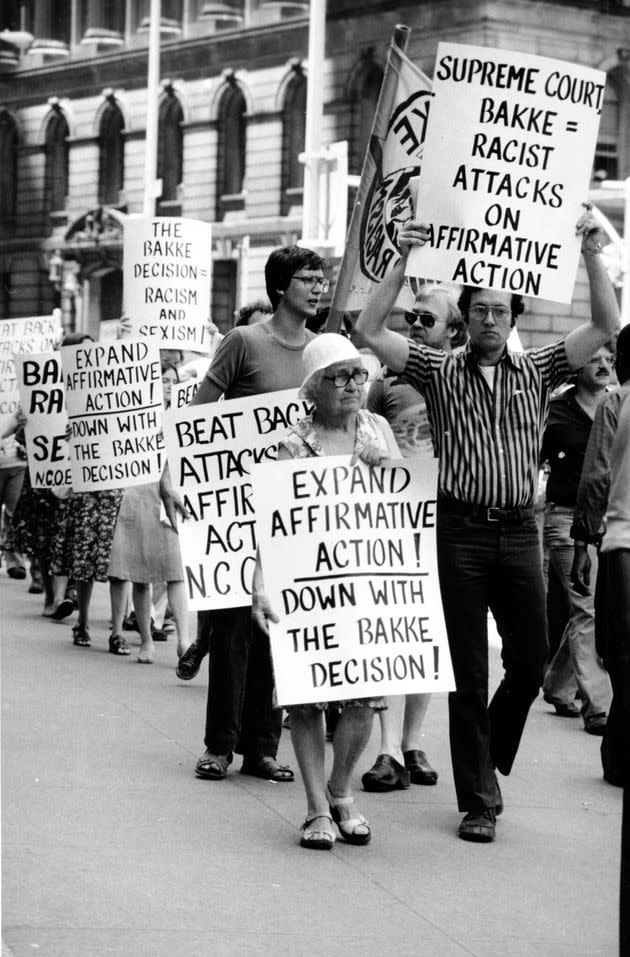Supreme Court Declares Affirmative Action In Education Unconstitutional
- Oops!Something went wrong.Please try again later.
The Supreme Court declared affirmative action programs at public and private colleges and universities unconstitutional on Thursday in a decision written by Chief Justice John Roberts.
The decision puts an end to most systems designed to help Black and Latino students access higher education after centuries of racial discrimination. Colleges and universities will no longer be allowed to seek greater diversity of their student bodies by preferencing race, although student applicants will not be precluded from discussing their race during the application process as it relates to their individual experience. The most immediate effect will be a decrease in the number of Black and Latino students admitted to the most selective schools, studies show.
In his opinion, Roberts stated that schools are not permitted to judge candidates for admissions based on their race.
“Many universities have for too long done just the opposite,” Roberts wrote. “And in doing so, they have concluded, wrongly, that the touchstone of an individual’s identity is not challenges bested, skills built, or lessons learned but the color of their skin. Our constitutional history does not tolerate that choice.”
Adopted in the late-1960s in the wake of the Civil Rights Movement, college affirmative action policies aimed to increase Black and Latino attainment in higher education. They faced instant opposition from many white Americans and conservative politicians who came to see them as a form of “reverse racism” that favored Black and Latino students over white students. In the 21st century, the artificially low admittance rate of Asian American applicants became a focus of opposition to affirmative action.
Asian American plaintiffs were at the center of the challenges in Students for Fair Admissions v. President and Fellows of Harvard College and Students for Fair Admissions, Inc. v. University of North Carolina, which have now ended affirmative action programs nationwide.

People rally in support of affirmative action in college admissions as arguments start on the cases at the Supreme Court on Capitol Hill on Monday, Oct 31, 2022 in Washington, DC.
The court split along ideological lines in both cases. Conservative justices Clarence Thomas, Samuel Alito, Brett Kavanaugh, Neil Gorsuch and Amy Coney Barrett joined Roberts in the North Carolina case while liberal justices Elena Kagan, Sonia Sotomayor and Ketanji Brown Jackson dissented. The result in the Harvard case split on the same lines, but the vote was 6-2 because Jackson recused from the case.
The majority opinion rejected the affirmative action policies used by both Harvard and UNC as failing to meet the standards the court previously set out, for not having a “logical end point” and, most importantly for the majority, for violating the 14th Amendment’s equal protection clause.
“[T]he Harvard and UNC admissions programs cannot be reconciled with the guarantees of the Equal Protection Clause,” Roberts wrote. “Both programs lack sufficiently focused and measurable objectives warranting the use of race, unavoidably employ race in a negative manner, involve racial stereotyping, and lack meaningful end points. We have never permitted admissions programs to work in that way, and we will not do so today.”
Roberts’ opinion pointed back to Justice John Marshall Harlan’s dissent in the 1896 “separate but equal” case of Plessy v. Ferguson to argue the use of race ― even to promote the equality of a long-discriminated-against minority group ― was unconstitutionally “pernicious.”
“[I]n view of the Constitution, in the eye of the law, there is in this country no superior, dominant, ruling class of citizens,” Harlan wrote and Roberts quoted. “There is no caste here. Our Constitution is color-blind, and neither knows nor tolerates classes among citizens.”
This outcome was not a surprise. The court’s conservatives have long taken a dim view of affirmative action. The last major case, 2016’s Fisher v. University of Texas, only achieved a majority that upheld some uses of affirmative action due to Justice Antonin Scalia’s death. With Anthony Kennedy’s departure in 2018 and Ruth Bader Ginsburg’s death in 2020, affirmative action’s fate was all but sealed.
Affirmative action programs in education grew out of efforts to promote racial equality. This began in the post-Civil War period known as Reconstruction through the establishment of the Freedmen’s Bureau, educational institutions like Howard University, and failed efforts to redistribute land and wealth. The 14th Amendment was also approved in the spirit of promoting racial equality following the end of slavery.

University of North Carolina Chancellor Kevin Guskiewicz talks with reporters outside the U.S. Supreme Court after oral arguments in Students for Fair Admissions v. University of North Carolina.
The reactionary movements of ex-slavers, however, blunted these efforts and, by the 1890s, defeated them. In 1896, the Supreme Court approved segregation policies in its infamous decision in Plessy v. Ferguson.
In 1961, amid the civil rights ferment in the Jim Crow South, President John F. Kennedy signed an executive order that ordered government contractors to “take affirmative action to ensure that applicants are employed and that employees are treated during employment without regard to their race, creed, color, or national origin.” His successor, President Lyndon B. Johnson, followed with a similar order using the “affirmative action” phrasing. He also signed the Civil Rights Act, which banned racial discrimination in employment and established the Equal Employment Opportunity Commission.
The spirit of affirmative action was voluntarily adopted at colleges and universities. Many of these programs operated on a quota system, with a set number of admissions guaranteed for Black students.
But these policies faced strong opposition from white Americans across the country, particularly as economic growth slowed in the 1970s. They splintered liberal coalitions as white people saw affirmative action as reducing their and their children’s chances of reproducing or exceeding their parents’ economic position.
In 1978, the Supreme Court heard arguments in its first big affirmative action case: Regents of the University of California v. Bakke. In a splintered decision, the court ruled that racial quotas for admissions were unconstitutional, but upheld the ability of schools to use race to some degree in admissions. The question was to what degree and for what reason.
In a solo opinion, Justice Lewis Powell decreed that increasing student body diversity was the lone reason to allow race-based admissions. The court fully adopted this reasoning in its 2003 decision in Grutter v. Bollinger while declaring points-based admissions policies that considered race unconstitutional. In that decision, however, Justice Sandra Day O’Connor declared that race-based admissions must have some endpoint.

Demonstrators protest the Supreme Court's 1978 decision banning the use of racial quotas in school admissions.
“The Court takes the Law School at its word that it would like nothing better than to find a race-neutral admissions formula and will terminate its use of racial preferences as soon as practicable,” O’Connor wrote at the time. “The Court expects that 25 years from now, the use of racial preferences will no longer be necessary to further the interest approved today.”
The court has now ended gutted those precedents and ended affirmative action 21 years later.
The dissenting justices to Thursday’s ruling noted the extreme irony of the majority’s use of the 14th Amendment to end programs aimed at producing greater racial equality.
“The Court subverts the constitutional guarantee of equal protection by further entrenching racial inequality in education, the very foundation of our democratic government and pluralistic society,” Sotomayor wrote in a dissent on the Harvard case.
“It is no small irony that the judgment the majority hands down today will forestall the end of race-based disparities in this country, making the colorblind world the majority wistfully touts much more difficult to accomplish,” Jackson wrote in her dissent on the UNC case.
While the decision ends race-based admissions policies, it does not deny the use of all forms of racial identification in admissions so long as they are through the lens of an applicant’s experience as an individual.
“[N]othing in this opinion should be construed as prohibiting universities from considering an applicant’s discussion of how race affected his or her life, be it through discrimination, inspiration, or otherwise,” Roberts wrote.
Still, Roberts added, “universities may not simply establish through application essays or other means the regime we hold unlawful today.”
In a footnote, Roberts also stated that the decision does not apply to military academies.
It is not clear how colleges and universities will respond. Nine states, including California and Michigan, have already banned the use of affirmative action in state school admissions. Despite these bans, they have sought other ways to create racially diverse student bodies.
It is not immediately clear what the court’s decision means for schools seeking alternative approaches to achieving a diverse student body.
In an email to “the Harvard Community,” Harvard University’s leadership affirmed its commitment to racial diversity and declared that it would be “drawing on the talent and expertise of our Harvard Community [to] determine how to preserve, consistent with the Court’s new precedent, our essential values.”
